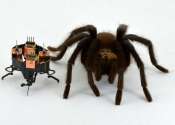Spider-inspired, shape-changing robot now even smaller
This shape-changing robot just got a lot smaller. In a new study, engineers at the University of Colorado Boulder debuted mCLARI, a 2-centimeter-long modular robot that can passively change its shape to squeeze through narrow ...
Nov 4, 2023
0
29









